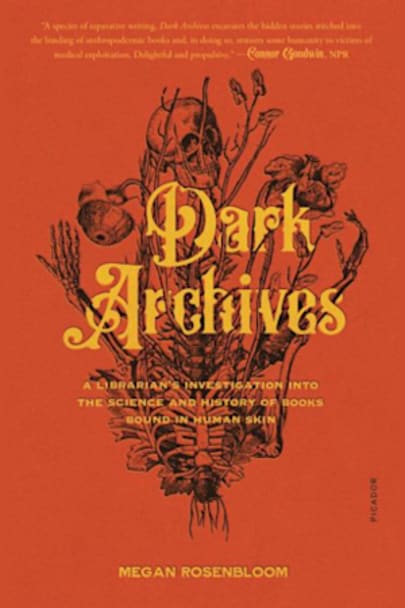On bookshelves around the world, surrounded by ordinary books bound in paper and leather, rest other volumes of a distinctly strange and grisly sort: those bound in human skin. Would you know one if you held it in your hand? In Dark Archives, Megan Rosenbloom seeks out the historic and scientific truths behind anthropodermic bibliopegy–the practice of binding books in this most intimate … this most intimate covering. Dozens of such books live on in the world’s most famous libraries and museums. Dark Archives exhumes their origins and brings to life the doctors, murderers, and indigents whose lives are sewn together in this disquieting collection. Along the way, Rosenbloom tells the story of how her team of scientists, curators, and librarians test rumored anthropodermic books, untangling the myths around their creation and reckoning with the ethics of their custodianship.
A librarian and journalist, Rosenbloom is a member of The Order of the Good Death and a cofounder of their Death Salon, a community that encourages conversations, scholarship, and art about mortality and mourning. In Dark Archives–captivating and macabre in all the right ways–she has crafted a narrative that is equal parts detective work, academic intrigue, history, and medical curiosity: a book as rare and thrilling as its subject.
more



“Anthropodermic bibliopegy had been a specter on the shelves of libraries, museums, and private collections for over a century. Human skin books -mostly made by 19th century doctor bibliophiles – are the only books that are controversial not for the ideas they contain, but for the physical makeup of the object. They repel and fascinate, and their very ordinary appearances mask the horror inherent in their creation.”
I have been following Megan Rosenbloom on Twitter for a while now and when I found out she was publishing a book about human skin books, I was instantly on board. I work in an archive and am around rare books all the time but I don’t actively work with them. I never considered that some might be bound in human skin so I found the concept fascinating and morbid.
I was hooked by the end of the first chapter. This book was fascinating and filled with the macabre detail of the history of these books. Rosenbloom does extensive research for each book and discusses what facts are known about the book and its skin donor, if that donor is known. I really enjoyed learning about her own experiences during her research and her feelings about what she found. While quite a few books did turn out to be bound in human skin many also turned out to be animal skin. Also quite a few of the institutions wouldn’t test their books so there are still quite a few unconfirmed human skin books out there.
“Anthropodermic books tell a complicated and uncomfortable take about the development of clinical medicine and the doctoring class, and the worst of what can come from the collision of acquisitiveness and clinical distancing.”
Intertwined with the history of these books we get the history of the doctors behind them. We learn about how these doctors wronged their patients by stealing skins for books, as well as other things. I found this section fascinating because I didn’t expect the doctors behind the book to be known. I am very interested in reading further on some of the doctors, particularly the anatomist Joseph Leidy and his unethical actions with the dead. I also really want to go to the Mutter Museum now to see a human skin book and the other objects that Leidy gave them.
“Human skin books force us to consider how we approach death and illness, and what we owe to those who have been wronged or used by medical practitioners.”
At the end of the book is a list of the confirmed human skin books as of March 2020. You can also find a list on the Wiki page for Anthropodermic bibliopegy with a link to the archives housing those books if you want further information about the archives or the book itself. .
Overall, this was a fascinating look at a very morbid topic. I loved how this was handled and the information presented to the reader. As someone who works in an archive and never considered the possibility of a human skin book, this was both very informative and eye opening. It presented me with new ways to look at the materials an archive might have and to consider my own views on the subject in relation to the archives. Your views may differ from an archive view on controversial items but their goal is to preserve all history and put it into context so people can learn from it.
*ARC provided by Netgalley for an honest review.*